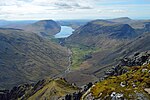Mosedale Beck (Wast Water)
CumberlandCumbria geography stubsCumbrian Esk catchmentEngland river stubsRivers of Cumbria

Mosedale Beck is a stream in Cumbria which runs into Wast Water, which is the deepest lake in England. Mosedale Beck rises in Little Scoat Fell, it then flows south west until it reaches Ritson's Force waterfall. It then turns to the south and flows through the hamlet of Wasdale Head. It then flows through Down-in-the-Dale before it empties into Wast Water near the parallel Lingmell Beck. The Mosedale Horseshoe is a celebrated mountain walk around Mosedale: starting at Wasdale Head it includes Yewbarrow, Red Pike, Scoat Fell, and Pillar.
Excerpt from the Wikipedia article Mosedale Beck (Wast Water) (License: CC BY-SA 3.0, Authors, Images).Mosedale Beck (Wast Water)
Old Corpse Road,
Geographical coordinates (GPS) Address Website Nearby Places Show on map
Geographical coordinates (GPS)
| Latitude | Longitude |
|---|---|
| N 54.4582 ° | E -3.2608 ° |
Address
Wasdale Campsite
Old Corpse Road
CA20 1EX , Wasdale
England, United Kingdom
Open on Google Maps











